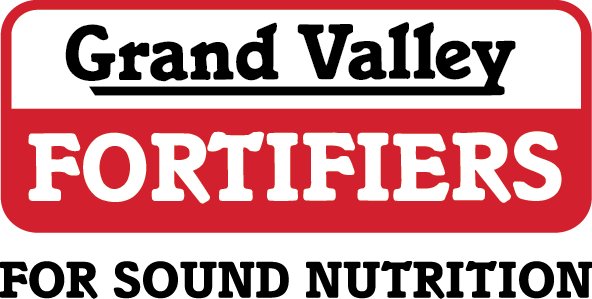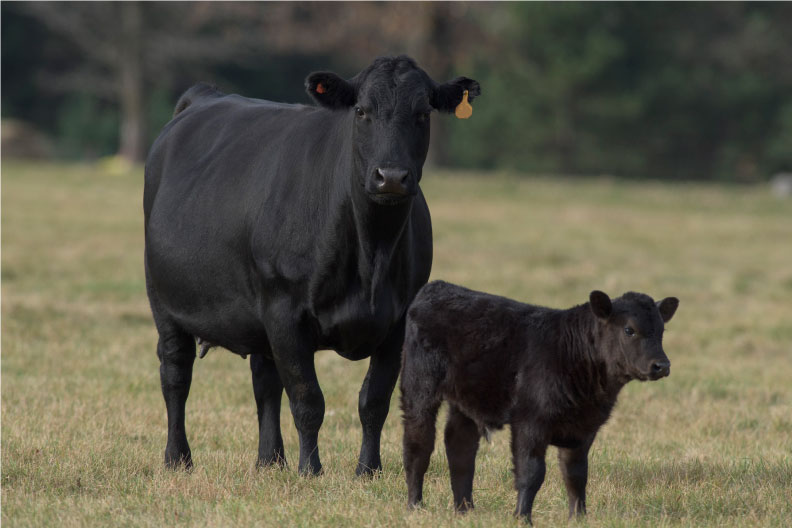By Josh DeVos
Ruminant Nutritionist,
Grand Valley Fortifiers
How a calf performs from birth to finishing is a function of their genetics and environmental conditions. A calf cannot change the genes that are supplied to them from their sire and dam. However, the expression of these genes can be modulated by their environment, including the nutritional status of their gestating dam. In fact, new research suggests that much of how a calf will perform later in life, whether in the breeding herd, or in the feedlot, may actually be set before they are born.
For example, the number of muscle cells that a calf will have during its life is set during early gestation (1st and 2nd trimester). After a calf is born, any increased muscling of this animal will be due to muscle cells growing in size, not growing in number. Therefore, during gestation, anything we can do to increase the number of muscle cells will have an exponential, lasting impact on the future productivity of that calf. As we will consider later, maintaining the energy and protein status of the gestating cows may be important for this function. Fat cells, unlike muscle cells, are not fully set during fetal development. A growing and finishing steer or heifer can increase in fat cell number as they progress toward their respective endpoints. However, the fetal phase of a calf still represents the most efficient time for a calf to increase their number of fat cells. This is because as the animal matures, it becomes increasingly energetically costly to grow these new cells. That is, growing the size of existing fat cells is much more efficient for more mature cattle than manufacturing new fat cells.
Several studies have been conducted to investigate the effects of gestating dam nutrition on subsequent calf performance. The effects of supplemental energy sources, such as corn or barley, during mid to late gestation have generally been unclear, with trials reporting conflicting results for calf weaning weight and endpoint carcass characteristics of the offspring. One explanation for this is that that dam will tend to sacrifice its own energy stores during a time of energy restriction for the sake of the developing fetus. Indeed, a cow that does not carry enough condition into lactation will prioritize feeding the newborn calf at the expense of maintaining enough body fat to breed back. Therefore, scientists have had trouble teasing apart how energy is supplied to the fetal tissues versus to the dam herself.
Supplementing protein sources to late gestation cows has yielded clearer results. Studies have noted that a cow lacking in protein status during gestation will result in a fetus that downregulates their muscle development genes versus calves with dams who have a sufficient protein status. This will result in calves born with an impeded ability to grow their frame as quickly. Since hay or haylage with reasonable protein levels (>12% Crude Protein) is able to supply adequate amounts of protein for the rumen bugs to break down, other studies have investigated feeding sources of protein that are not broken down by the rumen as easily, such as Dried Distillers Grains and Solubles (DDGS). These protein sources, referred to as “bypass protein”, may be beneficial as it is more available to the cow herself instead of only to the rumen bugs. These studies have found that gestating cows fed DDGS produced calves with increased birth weights and greater pre-weaning average daily gain. It has been suggested that cows restricted in protein will give birth to calves that perform poorly for growth and marbling compared to calves from cows with adequate protein status. More research is needed to determine the tangible economic benefits associated with supplying protein to gestating cows beyond what is required by rumen bugs.
Very recent studies have begun to look at how trace minerals and amino acids can factor into how a dam’s metabolic status during pregnancy may affect their offspring. However, the science behind these ideas are in the early stages. Regardless, we should increasingly consider the role of the gestating beef cow on the subsequent production of their progeny. Maintaining adequate protein and energy status in addition to a well-balanced mineral package is clearly associated with cow milk production and reproductive performance, but may also be related how the calf performs later in life.
In addition to energy and protein, a robust mineral program for the dam at all times is essential for reproductive fitness as well as calf survivability. Chelated trace minerals, such as chelated zinc, manganese, and copper, are more available to the cow. These complexed trace minerals have been well documented to help with immunity, conception rate, dystocia, birth weights, as well as milk quality. Therefore, for operational efficiency, a focus on maintaining the health of the cow herself pairs well with a focus on fetal development and subsequent calf performance. Nutrition Direct and your local Grand Valley Fortifiers Ruminant Specialist would be happy to speak with you regarding dietary strategies for cow and progeny performance.
This article was written for the Fall 2019 Beef Grist. To read the whole Beef Grist, click the button below.

